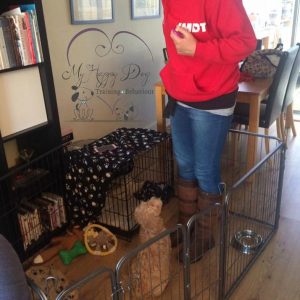Why confinement areas work

24 April, 2014 – 11:00
Ok so you have a new fluffy puppy coming, you’re excited, yeeeahhhhh, you’re anxious…. Ooohh yeeeahhhh, and you want everything to go just right! Well, that’s a big yeeahhhhh…. So let’s start with some ground rules…
Puppy arrives usually around 8 weeks’ old, we know this is important as it’s in line with critical development stages (see my blog about this for more details).
One area I want to talk about today is an area I’m a huge fan of, confinement areas. I want you to appreciate how they can benefit both you and, more importantly, Puppy. The confinement area gives you the confidence to know Puppy is safe, away from any dangers and can’t get into any mischief when you’re not there to supervise.
A confinement area is a tool not to be taken lightly. It can play a huge part in errorless toilet training, chew training and provide a calm space for Puppy to enjoy on their own.
So let’s break it down. There are two types of confinement, which briefly comprise the following:
- Long term – puppy playpen, bed/crate, water bowl, chew toys, toilet area.
- Short term – crate, bedding, chew toys.
Note that the confinement area(s) need to be secure and, in the case of long-term confinement, big enough to have separate areas for sleeping and playing.
Benefits of long-term confinement areas
The benefits of long-term confinement areas are that they:
- prevent your puppy from getting into mischief and learning bad habits when you are not there to supervise them.
- prevent your puppy from making mistakes around your house.
- maximise the chances of Puppy developing chew toy* habits, which will encourage alone time positively.
- help Puppy to learn to settle and be calm quickly and in a positive way.
- facilitate house training through Puppy learning to use the toilet provided.
* Great chew toys are toys that can be stuffed with appropriate kibble, remember to deduct the amount he has as treats from their daily recommend in take so as not to over feed puppy.
Benefits of short-term confinement areas
The benefits of short-term confinement areas are that they:
- prevents mistakes around the house.
- teach your puppy to have good chew toy* habits, making their time in the short-term confinement a positive experience.
- help Puppy to learn to settle down and be calm whilst in the crate.
- help you to better predict when Puppy will need to urinate as Puppy won’t soil their own bed; checking every hour by taking Puppy out will enable Puppy to understand what is expected.
* Great chew toys are toys that can be stuffed with appropriate kibble, remember to deduct the amount he has as treats from their daily recommend in take so as not to over feed puppy.
When at home, familiarise puppy with the different confinement areas and guide them to what is expected of them. Make it fun and ensure that all experiences are positive ones. Remember, confining Puppy when you’re around and making it a positive experience will enable Puppy to adjust to being left in a positive manner. Puppy will learn that the confinement area is a fun place to be, whether you’re there or not, with plenty of chew toys and things to do, rather than just associating it as a place they are put when you’re not around.
Why confinement areas work really comes back to what I’m always talking about, consistency. The area allows you to implement great structure and boundaries, allowing you to be consistent in how Puppy spends his time in there. This allows Puppy to develop calm and confidently, while you too can relax knowing that Puppy can come to no harm while playing or sleeping in the area(s). Puppy will only have positive experiences while in there, whether you’re with them or not.
Good luck with your confinement areas; you’ll soon see why I’m such a huge fan of using them as part of Puppy’s development.